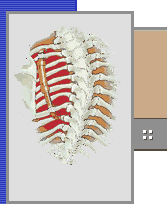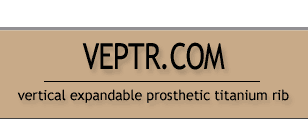 |
 Home : About VEPTR : Locations : Message forums : Photos : Stories : Links
Welcome to the unofficial website for the Titanium Rib Project!
Parents faced with caring for a child with restrictive lung growth deriving from congenital chest wall deformations such as scoliosis, kyphosis, Jeune syndrome (constricted chest), Jarcho-Levin syndrome (fused ribs), or missing ribs, the obstacles often seem overwhelming and mysterious. Traditional approaches to treating these complex cases have involved partial spinal fusions, rib separation, and often respiratory assistance in the forms of supplemental oxygen, CPAP, BiPAP, or even tracheotomy. In the more severe cases involving younger children, there is sometimes no approach that is entirely adequate. In recent years, the VEPTR device has gained further recognition in the orthopedic field. Rather than approaching the conditions of respiratory insufficiency at the spinal level or through ventilator support, the VEPTR device seeks to expand and support a deformed chest wall cavity through the use of telescoping titanium rods. These rods hook directly on to the rib cage or pelvis and help to separate and support the chest, giving the lungs room to operate and grow. In the case of scoliosis, and to a lesser degree kyphosis, the unattractive option of a spinal fusion is avoided, the leverage is instead placed upon the rib cage. In the other instances of collapsing or constricted chest walls, and spinal growth complications such as seen in Jarcho-Levin, the rods serve to help expand the chest to allow for the child to continue to grow and breathe. In many instances, these children's symptoms and conditions can be slowed, halted, or even reversed! As miraculous as the procedure may seem, the device is not suitable for every case. For example, older children and adults would not experience the same level of benefits, as the VEPTR implementation is designed to target the orthopedic challenges involved in treating these conditions on a growing body over time. Additionally, and as with any surgery, a patient should be medically stable enough to withstand the rigors of invasive surgery. Furthermore, various levels of complications often arise after the surgery, due to the nature of the implementation. All these factors must be carefully weighed before the decision to undergo VEPTR installation is made. In this spirit, we feel it is best for the dialogue between parent and physician to be as bilateral as possible. While you aren't likely to gain a medical degree in order to speak with your child's doctors on equal footing, it is important to arm yourself with as much information as possible. With knowledge comes understanding, and with understanding often comes hope. Please keep in mind that this material has been prepared with the help of other parents faced with similar situations, we do not possess professional medical credentials, and under no circumstances should any information presented here be considered medical fact-- rather it is the operation as viewed by us. Every situation is unique and consultation with your child's physician is required. You are not alone. |
|||
| Any information contained on this site should not be considered a substitution to qualified medical advice. Information here may be outdated, incorrect, or not apply to your specific case. Consult with with your physician for more details. Contact: VEPTR is a registered trademark of Synthes VEPTR.Com is an unofficial patient support site and is not affliated with Synthes |
xhtml 1.1 |